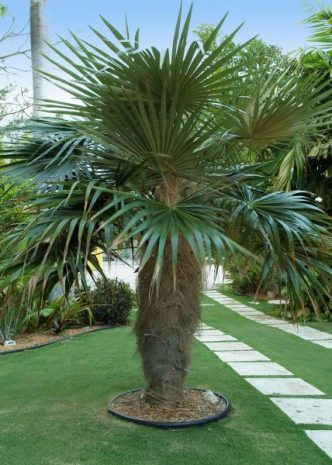A palm tree refers to an evergreen, unbranched tree of warm and temperate regions; it is a common name for perennial shrubs, lianas, and trees. The list of palm trees includes Pindo Palm tree, Triangle palm plant, Mediterranean dwarf palm, Mazari palm, Dwarf Majesty palm tree, etc. Out of many palm trees around the globe, Coccothrinax crinita is also the one.
Coccothrinax crinita is known; by names like guano barbudo, guano petate, old man palm, Palma petate. This palm tree is native to Cuba and has fan-shaped leaves. The tree serves as an ornamental plant; its leaves are used, like thatch. Other uses of Coccothrinax crinita include the provision of the trunk for the shelter, leaves for the bowls, and fibers for pillows. All of the merits of crinita play a vital role in its rarity. However, this species has now turned into an endangered species with only 60 to 130 trees left in Cuba.
Coccothrinax Crinita Growth Rate
The growth rate of the coccothrinax crinita tree in its habitat is usually slow, which is around ten years that are needed to help this tree reach 5 feet; however, the tree can grow up to 20 feet. Its usual range of growth is between 10 to 20 feet.
The coccothrinax crinita grows in well-drained and moist soils, preferably in serpentine soils or soils of low nitrogen, potassium, and phosphorus levels. The chief pollinator of this tree is the wind; however, the dispersal of the fruits takes place by various mammals. The good thing about this palm tree is that it can easily withstand low temperatures like 20 degrees Fahrenheit when it matures and sheds its oldest thatch during windy climates. It can also tolerate alkaline soils and drought.
Coccothrinax Crinita Size
The coccothrinax crinita tree is solitary and slow-growing; it is 2 to 10 meters in height or 7 to 33 feet. The trunk portion of this tree is covered; with long hair-like fibers. The stems are 8 to 20 centimeters or 3 to 8 inches in diameter. Despite the coccothrinax crinita size mentioned above, it appears large because of its thick covering of hair. The leaves are 15 to 25 palmately compound; these are green above and dull grey from below. The flowers are dioecious, which means the male and female flowers are present on separate plants and are yellow. After the production and pollination of flowers, fruits begin to appear. The fruits of the crinita are fleshy and are only visible in summers. Its fruits are round and wrinkled with either black or purple color; it is 0.7 to 2 cm in diameter or 28 to 80 inches in length.
Coccothrinax Crinita Care
The coccothrinax crinita plant is easy to maintain. It needs a few optimum conditions to grow best. While planting or growing the coccothrinax palm tree, always remember that the crinita prefers to grow in either full or partial sunlight. The kind of soil best suited for the growth of this palm tree is well-drained, moist, and non-clay. However, the crinita plant may also tolerate alkaline soils, drought, and nearby the ocean. The plant requires moderate amounts of water. Another thing that needs to be kept in mind is to protect the palm tree from the cool breeze during the early growth period. However, once the plant is mature, it can withstand even the lowest temperatures.
Coccothrinax Crinita Problems
Several problems are known to be associated with palm trees. The same goes for a coccothrinax crinita tree. The first problem related to this tree is overwatering. Overwatering the old palm or crinita tree causes its rotting. Another problem with the tree is that it develops an ashy grey or black mold that is not harmful to the palm but is considered odd to the tree. The tree may also exhibit yellowing which is lethal to its growth and development.
Sometimes, the coccothrinax crinita fungal problems or diseases also damages the tree; for this reason, it becomes necessary to get a hold of knowledge related to its health. The major setback caused to the crinita tree is a Ganoderma palm disease which is a white-rot fungus. This fungus causes the tree to die by causing trunk diseases. Improper pruning is also one of the factors contributing to the problems caused by it.



